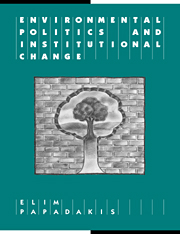Book contents
- Frontmatter
- Contents
- List of Tables and Figures
- Preface and acknowledgements
- Abbreviations
- Part I Introduction
- Part II Political Institutions, Innovation and Social Change
- Part III Political Organisations and Adaptation
- 8 Inertia and innovation
- 9 Missed opportunities: The Liberal and National Parties
- 10 Leading the charge for the green vote: The Australian Labor Party
- 11 Fundamentally green: The Australian Democrats
- 12 Overcoming institutional inertia
- Part IV The Media, Agenda Setting and Public Opinion
- Part V Conclusion
- Appendix: Codes used in tables 9.1 to 12.1
- Notes
- References
- Index
9 - Missed opportunities: The Liberal and National Parties
Published online by Cambridge University Press: 18 December 2009
- Frontmatter
- Contents
- List of Tables and Figures
- Preface and acknowledgements
- Abbreviations
- Part I Introduction
- Part II Political Institutions, Innovation and Social Change
- Part III Political Organisations and Adaptation
- 8 Inertia and innovation
- 9 Missed opportunities: The Liberal and National Parties
- 10 Leading the charge for the green vote: The Australian Labor Party
- 11 Fundamentally green: The Australian Democrats
- 12 Overcoming institutional inertia
- Part IV The Media, Agenda Setting and Public Opinion
- Part V Conclusion
- Appendix: Codes used in tables 9.1 to 12.1
- Notes
- References
- Index
Summary
The Liberal Party
The Liberal Party of Australia was founded by R. G. Menzies in 1944 and formally launched in August 1945. The party initially represented a coalition of anti-labour parliamentary groups, including former members of the United Australia Party, which had suffered a catastrophic defeat in the 1943 election. One of the issues that united the new group was the opposition to socialism and to the ALP (see Jaensch 1992). The other key factor in the new union was the leadership by Menzies, who dominated both the parliamentary party and the extra-parliamentary organisation until his retirement in 1966.
The structure of the party had three distinct features. The first was the emphasis on federalism, which allowed each state division to enjoy substantial autonomy (for instance, with their own branches, constitutions, platforms, electoral committees and conventions). The second feature was the creation of a mass base and a large membership. In 1950 there were about 100 000 members in Victoria and New South Wales; in 1975 total membership reached a peak of 130 000, and it thereafter declined to 69 000 in 1990 (see Ward 1991; Marsh 1995). (The ALP experienced a similar, though even more rapid, decline in membership over this period.) The third defining feature was the division between the mass organisation and the parliamentary wing. This feature of the party has remained almost unchanged since 1945.
- Type
- Chapter
- Information
- Environmental Politics and Institutional Change , pp. 81 - 94Publisher: Cambridge University PressPrint publication year: 1996



